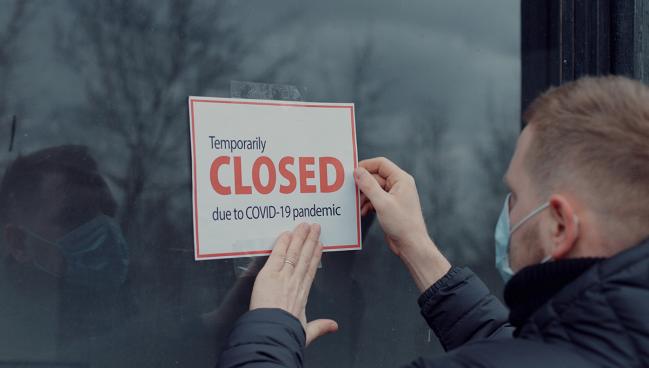TAVI Dipped Worldwide in Early COVID-19 Waves, but That’s Not the Whole Story
The TAVI trends mirror those seen for coronary procedures during lockdowns. Not captured are deaths for those untreated.

LONDON, England—It will come as no surprise to TAVI operators who had to shutter their doors and postpone or cancel procedures during the earliest stages of the COVID-19 pandemic, but new global data confirm that TAVI numbers dropped by nearly 20% internationally during the early months of lockdowns compared with the same period prepandemic for the different regions worldwide.
In happier news, those volumes ticked back up again during the second and third waves of the pandemic, returning to near normal levels by December 2021, said Xavier Armario, MD (Galway University Hospital, Ireland), who presented the numbers at PCR London Valves earlier this week.
Just as with the “missing STEMIs” during the strictest lockdowns of the COVID-19 pandemic, it’s not clear what happened to patients with severe aortic stenosis who went untreated during the pandemic’s peak, Armario told TCTMD.
“We have the TAVI data, but we don’t have TAVI mortality,” he told TCTMD. “The ideal would be to have the [overall] mortality for aortic valve stenosis, because we think it would increase for sure: because many people didn’t go to the hospital, or they were afraid to go to the hospital, or the hospital wasn’t taking care of these patients.”
Even if they had numbers of periprocedural TAVI deaths from the hospitals included in their survey, which might reflect a more-complex patient population, this wouldn’t give them any insights into how many patients died due to worsening aortic stenosis during the lockdowns without ever being admitted to hospital, he said.
Armario and colleagues collected data between January 2019 and December 2021 from 130 TAVI programs in 61 countries on six continents, ultimately including a total of 52,004 procedures.
Key observations included:
- TAVI volumes during the early months of COVID-19 were higher in Europe and North America, where they then bounced back more swiftly after the pandemic’s first wave
- TAVI growth rate prepandemic was higher in Asia and Central-South America and lowest in Africa; all regions faced greater slowdowns than North America and Europe during the first wave of the pandemic: Central-South America (-61.2%), Africa (-55.6%), Asia (-47.1%), North America (-24%), and Europe (-21%)
- Similar dips were seen in the second wave of the pandemic, which hit different regions at different times, but the drops were not as marked
- Urban centers, countries bearing a higher burden of COVID-19 infections, and countries with the strictest COVID-19 lockdowns had the biggest impact on TAVI activity
- In the third wave of the pandemic, TAVI activities in more developed countries bounced back to near-normal levels, while less developed countries continued to have lower TAVI volumes
Session chair, Philippe Généreux, MD (Morristown Medical Center, NJ), told TCTMD that the trends Armario reported are in line with what he saw at his own hospital, where TAVI activity had been growing by approximately 20% per year. This “stagnated” during the early COVID-19 lockdowns even though his hospital continued to do severe and urgent procedures.
“The cases we were doing were the heart failure patients, the extreme-risk patients—really the sickest of the sickest, so the first year of COVID we had more complications, more stroke, more mortality, and longer lengths of stays,” said Généreux. These will no doubt have an impact on hospital metrics when the Society of Thoracic Surgeons (STS) registry collates a full snapshot, he added, noting that other centers that shut down their structural heart programs entirely during peak COVID waves won’t have the same uptick in deaths and complications on record.
The switch to severe cases at his hospital only occurred for 3 to 4 months, so some AS patients with better heart function fared okay, he said. But “we had a lot of backlog and had to play catch-up for a couple months, so for sure some people died. We called them to book them and learned that they’d died.”
In some instances, those deaths were from COVID-19 itself, Généreux added, while others may have been from disease progression and/or hospital avoidance.
Armario said he’s hoping to do a follow-up study surveying the same hospitals to ask about TAVI mortality, which would help illuminate the complexity of the cases that were booked during the pandemic. Even better, he said, would be to ask hospitals about the number of patients who died on waiting lists during COVID-19 lockdowns.
“I could get that data from my own hospital, or maybe one or two hospitals, but most hospitals would not have that data, or they would not want to share it,” he said.
Shelley Wood was the Editor-in-Chief of TCTMD and the Editorial Director at the Cardiovascular Research Foundation (CRF) from October 2015…
Read Full BioSources
Armario, X. Impact of the COVID-19 pandemic on TAVI activity worldwide; the COVID-TAVI registry. Presented at: PCR London Valves. November 28, 2022. London, England.
Disclosures
- Amario reports no relevant conflicts of interest.




Comments